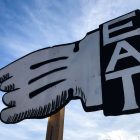Not Another Dark Holocaust Poem: Chava, Miriam, Auschwitz
It is tempting to dredge up ashy metaphors for your last days on earth
To remain riveted, horrified, impaled by thoughts of what it must have been like
Torn away from the comfort of a beautiful room, in your beautiful clothes, your ordinary Jewish lives
Turning away from the gathering gray clouds; the rumors, the stricken faces, the sinking fears pulling you into a reality too dreadful to be faced
And then, too late;
for Chava, for Miriam, too late
But wait, here is where I stop being able to go with you, onto that train, towards the sorting desk: live or die,
The barracks, the showers, the endings. Instead I carry you in my arms into the present
Into my music, quilting, cooking, tikkuning, praying and I feel you here in the invisible connections
Great-aunts with large breasts, recipes, laughter, wisdom, sewing machines, struggles: loving life, loving me.


